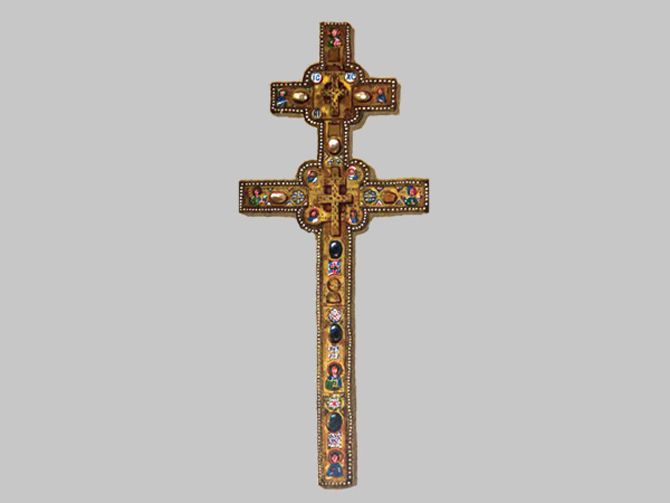Belarusians lost relic: Holy Cross of St. Euphrasinia
Author: Lida added 25-12-2012, 23:02
 In 1161 Belarusian saint Euphrasinia, mother superior of Polack Convent, ordered to a famous Polack master Lazar Bohsa (Bohsa is probably his second name, a short form of Bohuslau), a cross for the holy relics which were sent to her from Jerusalem and Constantinople. Such an important task was carried out under a close personal supervision of Euphrasinia, who is even considered to be the author of a draft for the cross. The cross has six-end form, which is a symbol of the creation of the world in six days; it was made of cypress which was used then to create the most precious objects of worship.
In 1161 Belarusian saint Euphrasinia, mother superior of Polack Convent, ordered to a famous Polack master Lazar Bohsa (Bohsa is probably his second name, a short form of Bohuslau), a cross for the holy relics which were sent to her from Jerusalem and Constantinople. Such an important task was carried out under a close personal supervision of Euphrasinia, who is even considered to be the author of a draft for the cross. The cross has six-end form, which is a symbol of the creation of the world in six days; it was made of cypress which was used then to create the most precious objects of worship.The cross was 52cm high and 2,5cm thick, with the upper crossbar 14cm wide and the lower 21cm. The wood was covered by twenty one pieces of gold incrusted with precious stones and decorated with twenty enamels, depicting Jesus Christ, John the Baptist, Theotokos, the Four Evangelists, archangels Gabriel and Michael, and three patron saints of Euphrasinia and her parents, which were not inferior to the best masterpieces of byzantine style. In the center of the cross in five pockets were placed a piece of the Holy Cross with drops of Jesus’ blood, a piece of Virgin Mary’s dwelling and other relics.

The cross has also of a significant historic and literary importance. Inscriptions engraved on the golden plates contain the name of the author of the masterpiece, the value of the precious stones and the master’s fee, and much other precious historical information. The fee of 40 hrywnas received by Bohsa, was a considerable sum of money at that time: its value was equivalent to a thousand and a half of fox skins or to four thousands meters of wood-paved roadway. This is the evidence of his free and well-off position within the society.
A curse to anyone trying to steal, sell or just to take the cross off the monastery didn’t appear to be all-powerful. At the end of the XIIth century the cross was taken off the Polack by the princes of Smalensk and placed in the Uspenski cathedral. After the capture of Smalensk in 1514 by the prince of Moscow Vasil’ III it was taken to Moscow. During the Polatsk (Livonian) war Moscow prince Ivan the Terrible ordered to return the cross to Polack, probably trying to pray for forgiveness of the carnage organized in Polack on his order.
After the Great prince Sciapan Batura gave the Church of the Saviour to the order of Jesuits, the citizens of Polack kept the cross in the Cathedral of Saint Sofia which belonged to the Uniat Church until the end of the XVIth century. In 1812 when Polack was captured for a few days by the french troops, the Basilians concealed the cross in one of cathedral’s niches. On the day of Euphrasinia the Saint in 1841the relic was moved back to the Church of the Saviour by a cross procession.
Under the Soviets the cross was confiscated by the bolsheviks. A special expedition was organized by the director of Belarusan state museum, Vaclau Lastouski, to move it to Mensk from the residence of bolsheviks in Polack. In 1929 it appeared in Mahileu where it was a part of a museum exposition for some time, and then was kept in a safe room at the regional communist party committee, from where it disappeared in 1941. After the liberation of the city the price of the cross was estimated at six million soviet rubles (more than 8 million dollars in the prices of the 20s of the 20th century).
The official soviet version according to which the cross was stolen by the Nazis is not trustworthy. Mahileu was located far from soviet-german border and it was enough time to evacuate it and the relic is likely to move east. On the official request from the Mahileu regional museum to the Hermitage museum of Saint-Petersburg, it was reported that just after the end of the war the cross was sold by auction to a private New-York Morgan founation. It was searched for at various times by scientists Adam Maldzis and Georgi Styhau, journalist Ales’Lukashuk, belarusan emigrants in the USA Vitaut Tumash, Vitaut Kipel’, Anton Shukeloic. In 1990 on the official request from the Ministry of Foreign Affairs of the Republic of Belarus the Morgan foundation replied that it was not in the possession of the relic. But as it was clear from the reply, members of the Morgan family owned their personal collections for which the foundation was not responsible. In recent times the Interpol has also joined for the search of our national shrine and have registered it under the registration number 34-1130.
Donate:















